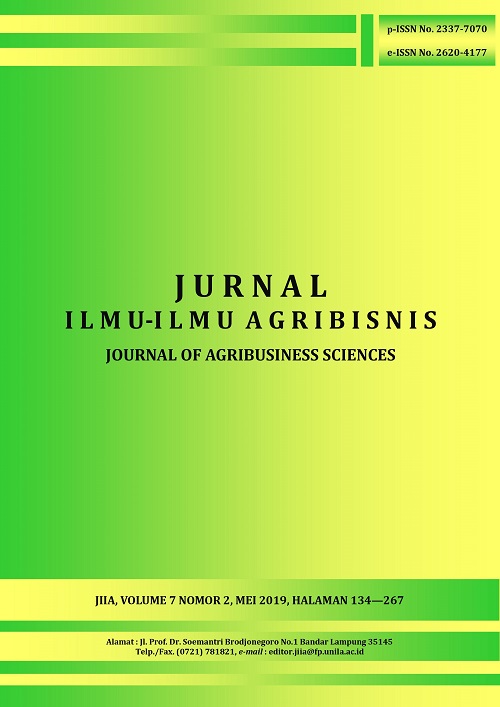ANALISIS USAHA, NILAI TAMBAH, DAN KESEMPATAN KERJA AGROINDUSTRI TAHU DI BANDAR LAMPUNG
DOI:
https://doi.org/10.23960/jiia.v7i2.3383 Abstract View: 2123
Abstract View: 2123
Abstract
The objectives of this study are to analize the business, the added-value and employment of the tofu agroindustry in Bandar Lampung. This study was conducted in Gunung Sulah and Kedamaian villages which are the tofu production centers. The respondents are randomly chosen. The data are processed by using the financial analysis and the value-added analysis. There are two kinds of tofu, i.e the kopong tofu dan the cina tofu. The average net revenues over the cash costs were Rp10.49 million/month of the kopong tofu and Rp12.10 million/month of the cina tofu. The average net revenues over the total costs were Rp4.02 million/month of the kopong tofu and Rp5.17 million/month of the cina tofu. The average standard costs were Rp16,949.97/kg of the kopong tofu and Rp9,206.70/kg of the cina tofu.The average added-value was Rp5,109.31/kg soybeans and its 95 percent confidence interval was Rp2,864.23-7,354.39/kg soybeans. The employment in the two tofu production centers was 143 people.
Key words: added value, agroindustry, business analysis, employment, tofu
Downloads
Downloads
Published
How to Cite
Issue
Section
License
Authors who publish with this journal agree to the following terms:
Authors retain copyright and grant the journal right of first publication with the work simultaneously licensed under a Creative Commons Attribution License that allows others to share the work with an acknowledgement of the work's authorship and initial publication in this journal.
Authors are able to enter into separate, additional contractual arrangements for the non-exclusive distribution of the journal's published version of the work (e.g., post it to an institutional repository or publish it in a book), with an acknowledgement of its initial publication in this journal.
Authors are permitted and encouraged to post their work online (e.g., in institutional repositories or on their website) prior to and during the submission process, as it can lead to productive exchanges, as well as earlier and greater citation of published work (See The Effect of Open Access).














